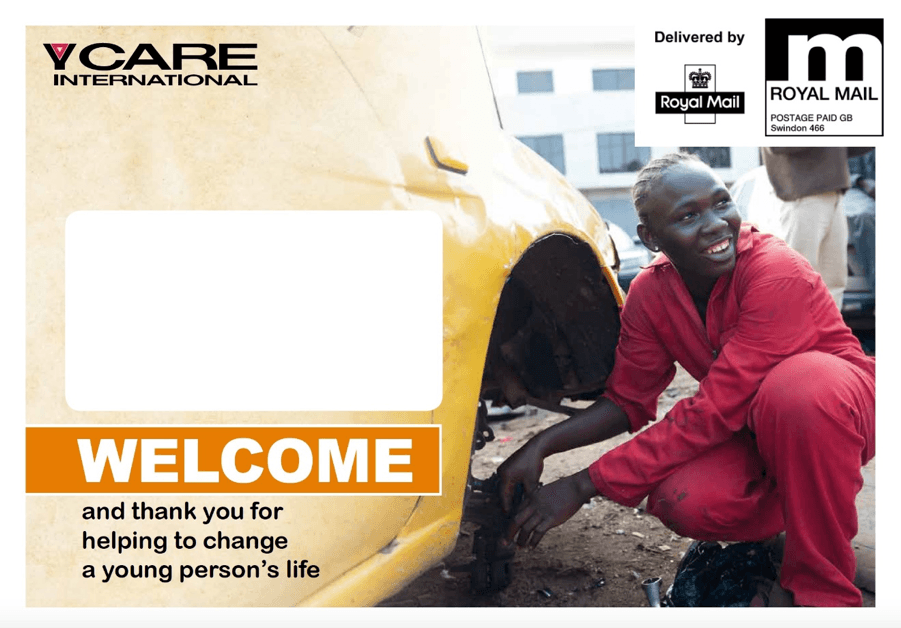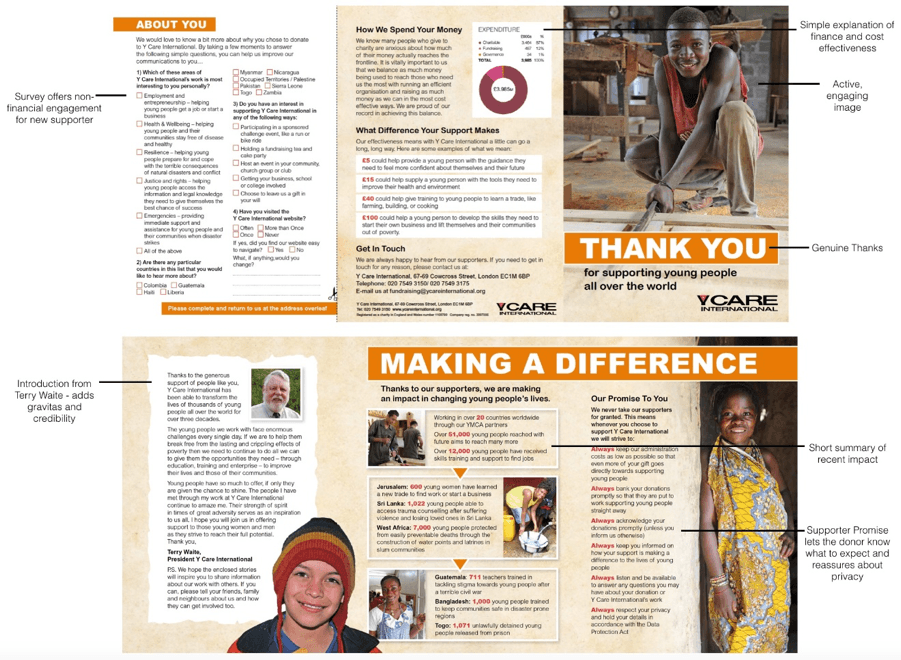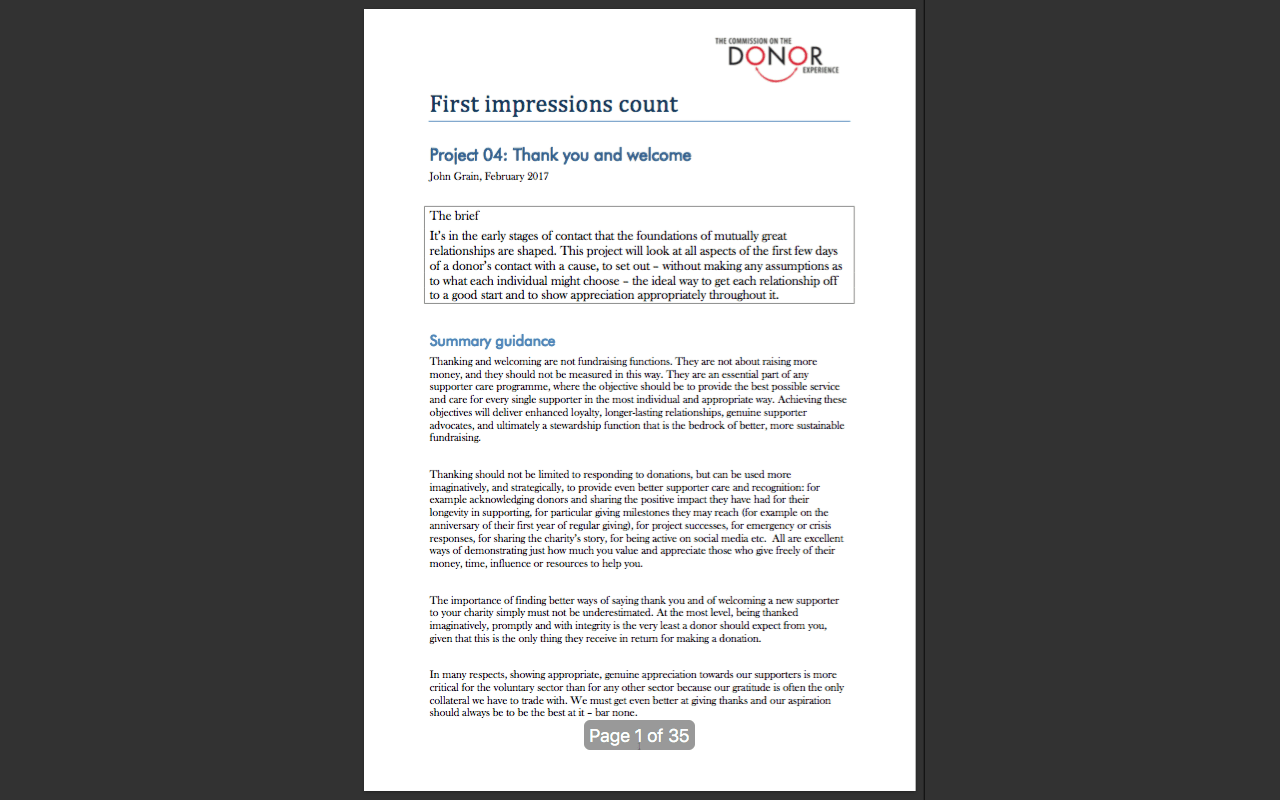CDE project 4 section 3: appendix 1 — case studies
- Written by
- The Commission on the Donor Experience
- Added
- April 28, 2017
Appendix 1: case studies
1. SolarAid
2. Innocent Drinks & Age Concern
3. Hope and Play
4. Alzheimer’s Society
5. Y Care International
1. SolarAid
SolarAid view thanking as an opportunity to engage supporters and help spread their story. This culture and philosophy of great thanking and appreciation is at the heart of their fundraising philosophy, which is not centred on how to get money out of people, but on how to inspire them to spread their story. They have found that people will often share a genuine, well-thought-out thank you with others, thus inspiring new people to get involved.
The example below demonstrates this to excellent effect. A blog post from a supporter talks about his son who had collected £24 for SolarAid and who received a personal thank you card in response.
“Anyway, Harry collected £24.00 and we sent it off to SolarAid with a note from the man himself. Yesterday a card arrived with delightful personal messages to Harry from the SolarAid team thanking him for his efforts. Cue misty eyes from his parents.
So if you do want to make a contribution to those less fortunate this Christmas, my whole hearted recommendation would be SolarAid!”
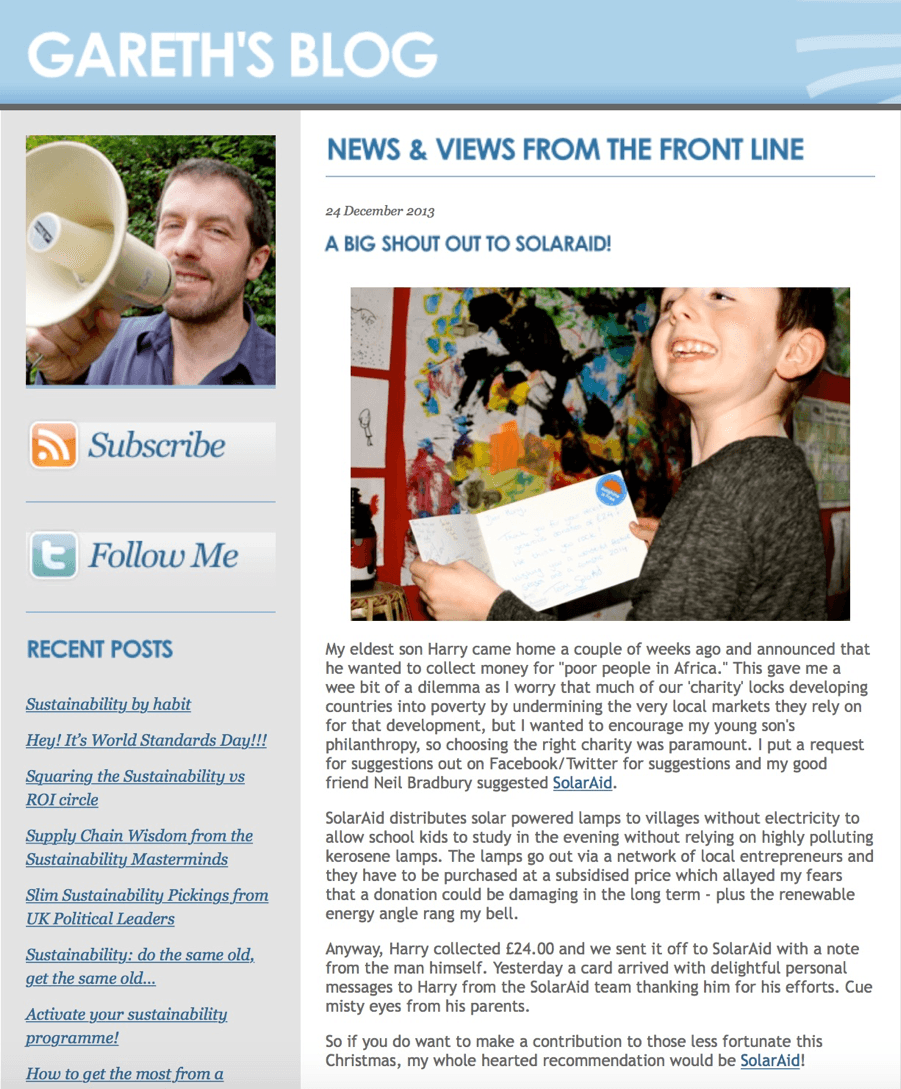
SolarAid had realised that one of the most effective ways to get their mission and story across was to simply show people a solar light. These lights are well made, bright and handy. Whilst at an awards event, a guest offered to buy the solar light a staff member was carrying around. The light cost the charity about £5, and the donor bought it for £50. The next day, a guest at the SolarAid office did the same. Based on this experience, SolarAid decided to do two things as part of their thanking. First, they offered to send donors a solar study light if they gave a donation of £50 or more (this fell within the gift aid incentives permissible in the UK; for donations up to £100, you can give a benefit of up to 25 per cent the value of the gift) and second, they began to offer a solar light to donors who had a direct debit with them for a year.
This thanking approach paid dividends in many ways. One week the charity saw they were getting a run of new donors all from within a similar postcode. They could not figure out why, but then received a call to the office from another new donor from the same postcode wishing to give £50. He specifically asked if he would be entitled to a solar light. Of course, SolarAid said yes and asked “how did you hear about us?” they were told “Oh, it’s Dorothy at number 4, she has one of your solar lights and has been knocking on everyone’s door in the street asking people to donate to your charity”.
SolarAid also prepared some cards with photographs of their work, reminding people of their mission with a thank-you photograph on the back from one of the programme teams, but entirely blank inside. This enabled them to write messages to supporters in response to a donation. Sometimes staff (not just those involved in fundraising) would all sign the card (say to a school or a church). Having the cards available made it easier to send something out. They found that people sometimes replied, thanking SolarAid for the thank you and sometimes shared the thank you on social media.
As part of measuring progress towards its goal SolarAid, had a team working on the impact of their work. They conducted research that established the impact of each solar light - for example, over three years a solar light led to over a thousand hours of extra study for a child. As they could equate donations to the number of solar lights they sold, they could equate donations to impact (for every £3 SolarAid received, they sold a light at a fair market price in Africa - this took into account all their costs, including fundraising). From this data, they created a calculator that converted money into impact and embedded it online:
http://solar-aid.org/online-impact-calculator/
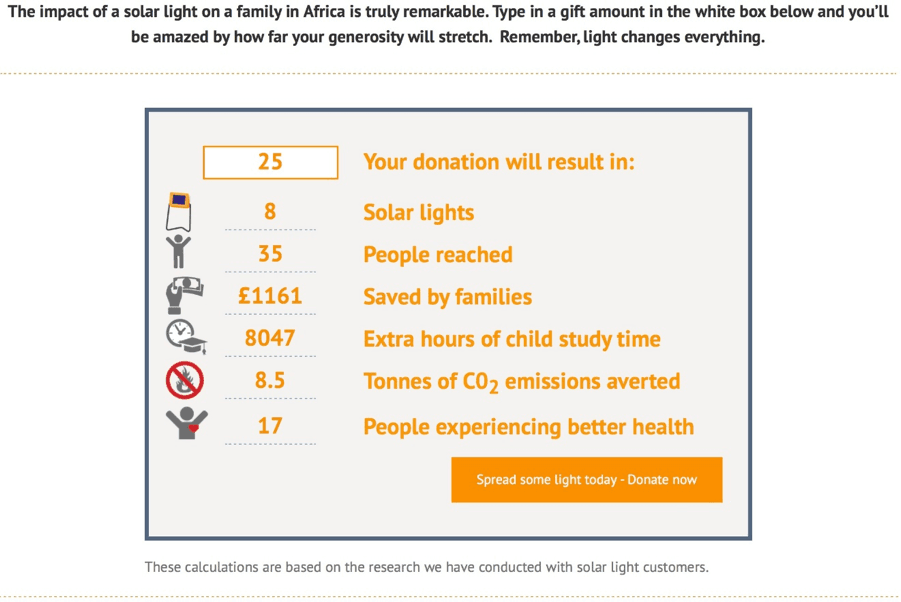
This could then be used in several ways as part of the thanking process.
Thinking about engagement led SolarAid to ask what they could do when people gave online that helps engage them and makes them feel good. The answer was brilliantly simple – they added a box asking why. This meant they could also refer back to their comment when thanking the donor and make it a more personal and authentic communication.
Donors told them with a range of comments demonstrating what was inspiring them to give, and SolarAid would send the best comments around to all staff and trustees each week as part of a weekly update.
They even gained an insight as a result. A number of donors were telling them they were giving to offset their carbon footprint. As a direct result of this discovery, SolarAid changed their SEO terms for anyone searching for a carbon offset charity to make sure SolarAid came up as an option. This is a great example of really listening to donors.
During the Big Give weekend in 2015, a couple of SolarAid staff worked over the weekend, and when someone gave online, they responded with an immediate, personally written thank-you email as along with the automated one the donor would get from donating to the Big Give. They introduced themselves and told them of the impact of their gift, equating their donation to the number of solar lights they could sell. Then they invited the donor to ask any questions they might have. This created great supporter engagement as you would expect, but they noticed something else – prompted by this thank you, some people started giving a second donation!
In April 2014, when SolarAid approached a million solar lights distributed to families in Africa, they decided to do a campaign to thank all their donors over recent years – they could genuinely say every donation had helped them achieve this milestone. They produced a special video to say “thanks a million” (https://www.youtube.com/watch?v=1rjZGcEnMDU) and sent out an email, along with postcards.
Additionally, for a week the staff plus volunteers got on the phone to thank as many donors as possible in person. There was no ask.
One donor was so taken aback she asked the caller to repeat what he had just said. He thanked her again for her support and told her of the milestone they had achieved - only to find she had put him on speaker phone for her whole family to hear! Years later, they still have people who say I remember you, “You’re the charity who called me up to say ‘Thanks a million’”.
2. Innocent Drinks & Age UK
Since 2003, Innocent Drinks have supported Age UK by encouraging customers and the public to knit little hats to go on the top of their smoothie drinks at Christmas time. Imagination and originality is encouraged, and for every one sold 25p is donated to Age UK. Over the years, a huge hat-knitting community has been built up and has been brilliantly supported and celebrated by Innocent via a dedicated website and on their blog on their own company website.
These two examples below, sent seven years apart, demonstrate how brilliant Innocent is at thanking and recognising the people that support their Big Knit campaign. There is much to be learned from the tone of voice, the style, and the sheer originality and authenticity of the thanking.

Surely we couldn't reach 500,000 hats. Could we?
It's been all hands on deck this week at Fruit Towers as we counted our little socks off to see if we could reach our target of half a million hats. Having all hands on deck was pretty useless really. The only decking we have is outside, and all the hats were inside. And there's not much decking anyway, and rather a lot of hands in Fruit Towers, so it was pretty cramped. It's also been raining these last few days.
But we soon realised the error of our ways and got back inside to continue the count.
Which is why, at 6.09pm Greenwich Mean Time yesterday evening, when we totalled up all of our unpacking, we can reveal with absolute accuracy that we cruised beyond our target of half a million hats (we're currently on 501, 423 - and still counting).
Now, if we were American, this would likely be cause for some serious high fives, a few chest bumps and plenty of butt slaps. But we're not American. We're British. And we didn't quite know how to celebrate. So I climbed into a Perspex box and got covered in hats. It seemed the sensible thing to do.
And made me rather happy.
In fact, we're all rather happy here at fruit towers. 501, 423 hats really is a staggering amount. And we're so, so grateful for your incredible knitting efforts. So, for anyone who has knitted a hat, wherever you may be, please stand up now and take a bow. You've been amazing. And we love you all (or if there's more than one of you, why not try a little chest bump action?).
We'd also like to say that although we often showcase the more creative hats we've received here on our blog, please don't think that we're not just as impressed by all the other hats. We know that each and every one is a labour of love, and we're in awe of them all.
At the end of the day, every single hat we receive means 50p for Age Concern, and that's the main thing.
There's still a few packages to be unpacked here in the office, so we'd best get back to it. Think we'll all be quite sad when there's none left to unpack. It's been like Christmas every day these past few weeks...
And don't forget people, the hats will be on shelf in Sainsbury's stores around the country from 5th November, and they do tend to be snapped up pretty quickly, so get yourself down there pronto to avoid disappointment. And in doing so you'll be helping us raise £250,000 for Age Concern to help keep older people warm this winter.
Again, thank you.
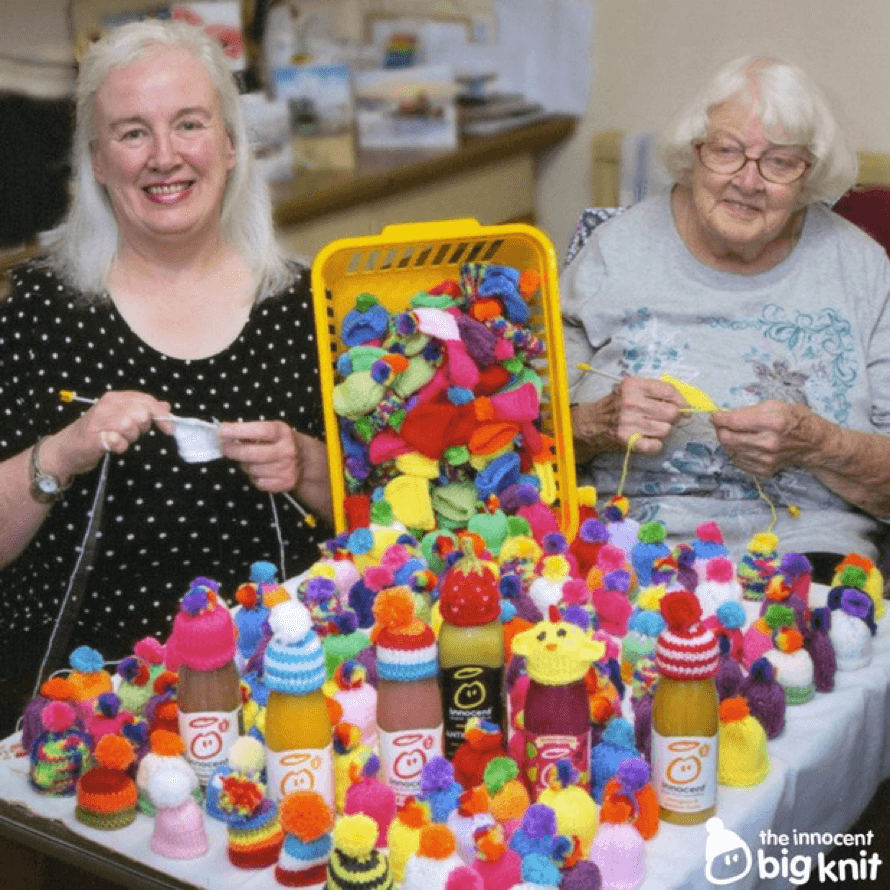
Hilary and her 92-year-old mum, Lily, knitted over 300 hats for us this year. We’re pretty sure Lily might be one of our oldest knitters this year. A massive thanks to them (and that chick hat at the front is genius).
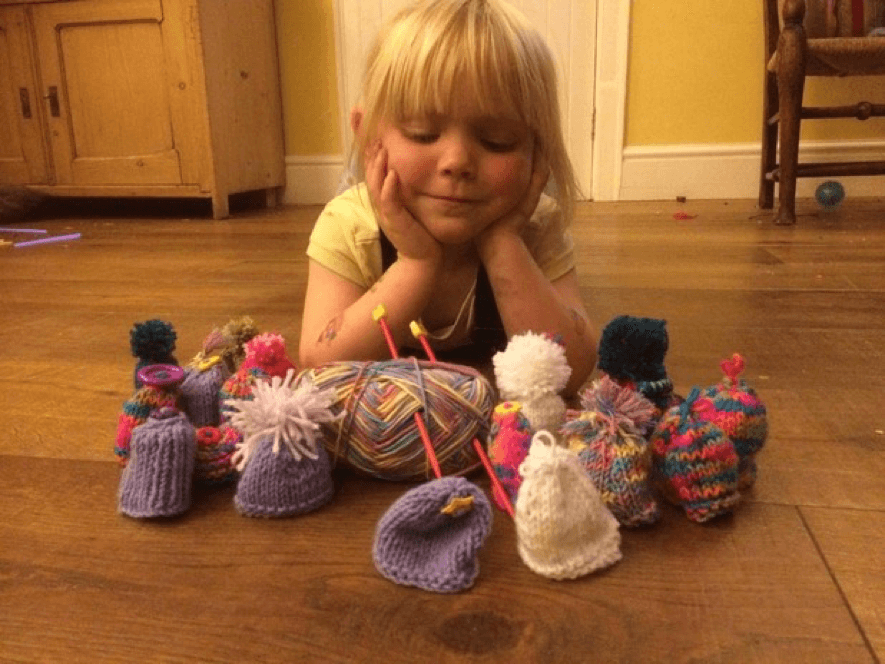
Katherine, on the other hand, is just four years old and possibly our youngest ever knitter. Her mum let us know that she'd managed to make 15 of her own Big Knit hats (with only a little bit of help). Thanks, Katherine (and Tiffany too, of course).
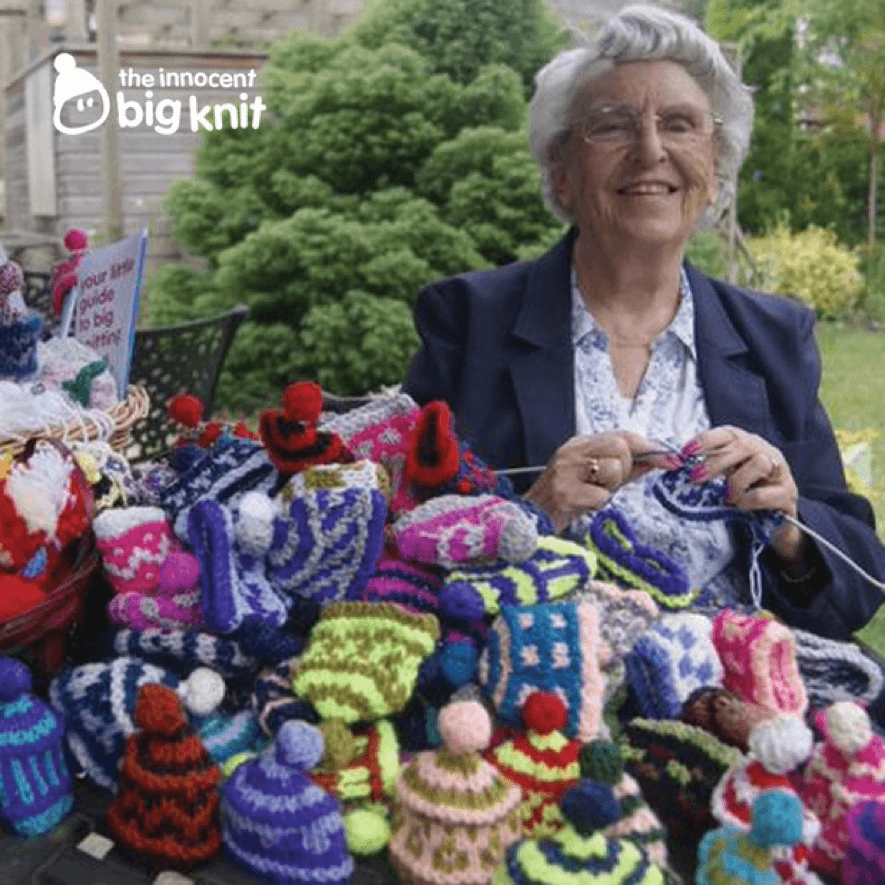
Stella found herself in hospital back in 2011 and took up knitting Big Knit hats as a way to keep herself busy. Since then, she’s made over 1,400 hats. That’s enough to fill an entire football stadium (albeit a miniature one). Cheers, Stella.
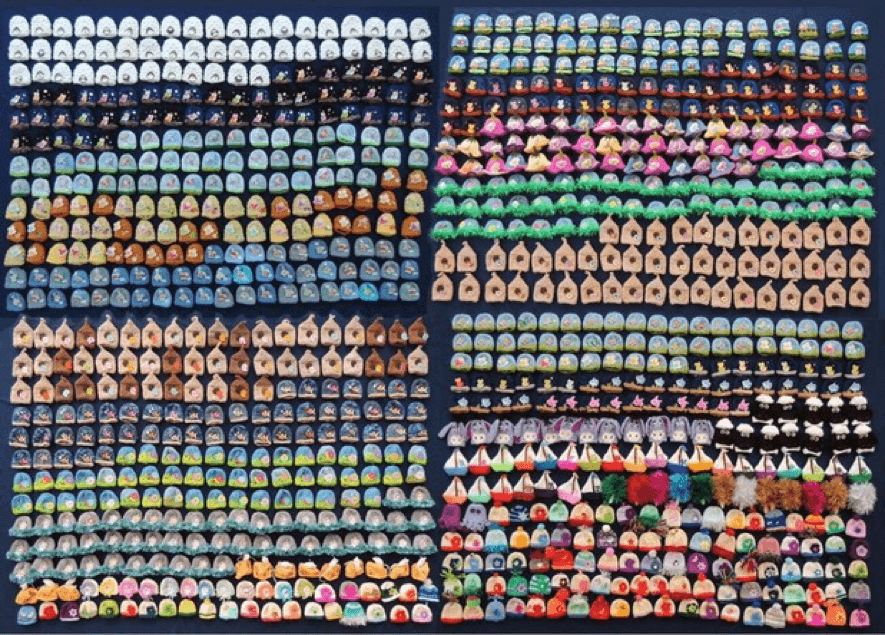
Jo has been involved with the Big Knit for years. She even started her own website entirely to help others take part. She’s very much a legend round these parts so we can’t say we were surprised to find out she’d made 1000 hats this year. We’ve said thank you to Jo many times over the year, and we’ve no trouble saying it again. Thanks, Jo.
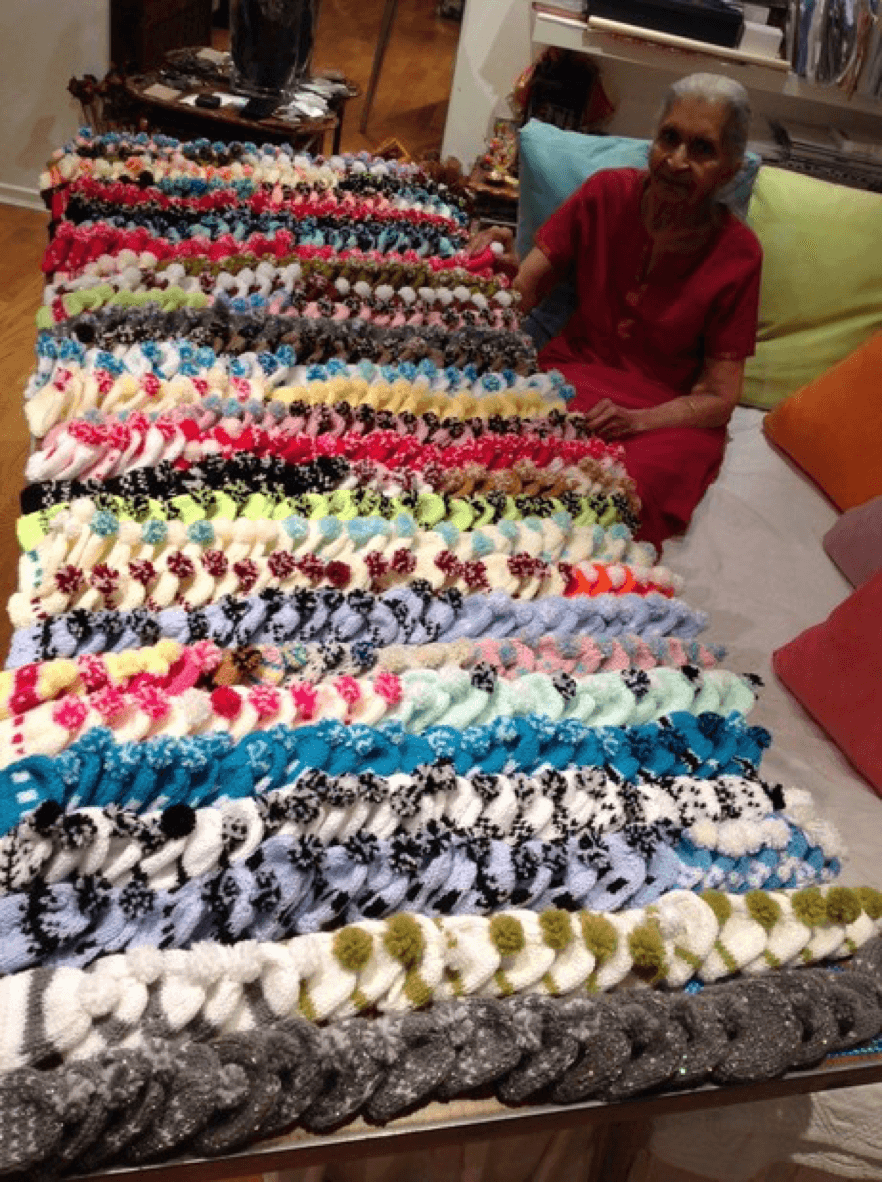
Last week Rashmi got in touch with us via Twitter and Facebook with an amazing bit of news about her mum knitting over 1,000 hats for us. We retweeted it, obviously, and felt all warm as loads of strangers sent in messages of thanks and support. The Internet can be a wonderful thing. Thanks, Rashmi’s mum. You're a knitting superstar (like Beyoncé but with knitting needles).
We love finding out more about our knitters. Please do drop us a line if you know of somebody amazing who you think should get a mention. Thank you again to everyone above, everyone who isn’t and everyone who will be in the future. You are all the best.
3. Hope and Play
Below is a thank-you email that would make any donor’s heart soar. Note the PS, which might make the donor think twice about opting out from such heart-warming communications.
From: Hope and Play
Date: 15/10/2016 18:13 (GMT+00:00)
To: David
Subject: Your donation to Gaza's children
Dear David,
Earlier this year, you kindly donated £300 to help get school books, stationery and bags to children in Gaza. Well, with your support, we reached our goal, and the children have all been given their much needed supplies for the new school year. Check out the colours on those rucksacks.

Just as importantly, they were given a message that someone is thinking of them. After nearly a decade of the brutality of siege and violence, of warplanes and of bombardment, many of them feel that the world watches and doesn’t care.
You told them that you care.
So thank you very much for your donation. You’ve made a difference to 300 children who need it. You can see some of the pictures up on our Facebook page at https://www.facebook.com/hopeandplay/posts/1308062085885227.
Lastly, as you may know, our volunteer artist, Jackie, kindly created a copy of our best selling print, the Palestinian Songbird, for us to give to those donors generous enough to support us with £50 and over. As you very kindly did so, we will be sending you this by post to the address we have for you. THANK YOU!!
With our respect and thanks,
Saskia and Iyas,
Trustees at Hope and Play.
P.S. You opted not to receive marketing communications from us. Please rest assured, you are not on our marketing list. This email is simply to let you know your donation has been used (there's not even a link to ask you for another!). You will not hear more from us, even though we remain very grateful for your support.
4. The Alzheimer’s Society
The Alzheimer’s Society have been developing a comprehensive Welcome programme as part of their wider Supporter Journey work. The following are their Welcome Pack development guidelines.
What is a Welcome?
It is essentially an amplified thank you, which the supporter receives after completing an action. An action can either be completely an event and giving in all their sponsorship, making a single gift such as cash or an in memoriam donation, or signing up to a regular product such as a membership or regular giving. It is not something that is sent to enquirers or someone who has signed up to an event, not is it a “Welcome to the Product”, as this may happen before the “Welcome to the Society” communication.
What should it contain?
- The words “Thank You” rather than “Welcome” should be used, as it is important that the organisation recognises the action that the supporter has just undertaken.
- The recommended signatory for this communication is as follows:
- Individual supporters, Groups & Associations – service user or person working at a service
- Trusts, Corporates & Major Donors – Jeremy to sign
- It should include the following things:
- There should be no direct ask in this communication; however, something ‘light touch’ is acceptable. For example: “Other Ways to support us – Leave a Legacy, Become a Dementia Friend”.
- Signposting to services.
- Information about the Society and the impact that the giver’s donation is having.
- The opportunity to give feedback or collect more information, such as an email address.
- Details of where more information can be found online.
- A case study demonstrating how essential their donation is, which should help give them a reason for future support.
5. Y Care International
Y Care International redesigned their Welcome Pack for new donors in 2015 to be more appreciative of a new donor’s support, to offer a better and more inspiring introduction to the work of the charity, to reassure the supporter about how money was raised and spent and how they, as a new donor, would be treated. It also included a simple survey to provide an opportunity for the donor to re-engage with the charity in a non-financial way and to provide some helpful information for the charity to use.
It is an A5 pack consisting of a covering letter, three panel A5 leaflet and a set of four postcards that visually introduce Y Care International’s work. These can be mixed and matched as appropriate.
It has been extremely well received, with many positive comments from new supporters.
